A self-drive road trip through Namibia is an incredible way to see the country. We spent months planning our Namibia itinerary which was a self-drive route through most of Namibia’s highlights from the capital Windhoek, to the desert sands of Sossusvlei, to the wilderness of Fish River Canyon, to the rugged Skeleton Coast and the safari Big 5 in Etosha. From the desert to the bush and the coast, we were blown away by the variety of sights and scenery on our journey. For any of you planning a trip to Namibia, we’ve put together the ultimate Namibia itinerary to help you plan your trip.
Namibia Itinerary
Most visitors (like ourselves) to Namibia will arrive at Windhoek Hosea Kutako International Airport which is broadly located in the centre of the country. We rented a car in Namibia which we picked it up from the airport.
Our recommended Namibia route is best suited to a three or four-week itinerary but can easily be extended if you prefer to travel more slowly and spend longer in a destination.
Namibia Itinerary tip: We highly recommend reserving a 4×4 car for your time in Namibia! While it is possible to drive a regular car, the roads in Namibia vary from excellent to dirt road standard and a 4×4 makes for a much more comfortable ride. It also allows some off road fun in places like Sossusvlei and the Skeleton Coast.
Namibia Itinerary Route Map
Namibia: arrive by air to Windhoek (1) – Fish River Canyon (2) – Kolmanskop/Lüderitz (3) – Sossusvlei (4) -Walvis Bay (5) – Cape Cross (6) – Damaraland (7) – Etosha National Park (8) – Windhoek (1)
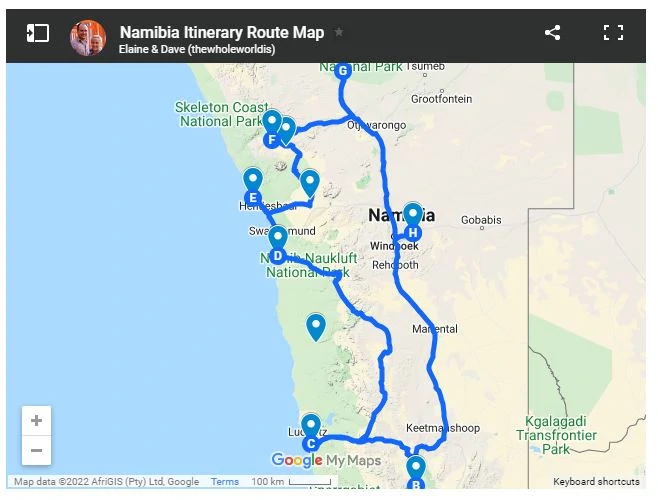
How to Use This Google Map: Click on the grey star at the top of the map and this map will be added to your Google Maps account. You can then view it on your phone or computer in Google Maps by clicking on the menu button, going to “Your Places” and selecting this map. We use these maps all the time as you can set out your itinerary ahead of time and quickly reference the saved maps.
Renting a Car in Namibia
Renting a car in Namibia is the best way to explore the country. Most of the main roads are good quality and the gravel roads are very safe to drive. If you are planning to drive any gravel road routes (and chances are you will) we recommend getting a 4×4 as it will make driving much more comfortable. Having your own car gives you the flexibility to travel at your own pace and explore all the hidden sights Namibia has to offer.
We’re huge fans of road trips and have driven rental cars in almost 50 countries so we have a lot of experience renting cars in foreign countries. Book your car now with DiscoverCars.com, where you will find a great selection of cars at competitive prices – check prices now!
Book your Namibia rental car now
Day 1: Arrive in Windhoek
There are some good food and drinks options in Windhoek and Christuskirche, a German Lutheran church in a unique building, is worth checking out. We arrived in Windhoek after a full day of travel from Dublin, Ireland and opted to catch up on some much-needed sleep before starting our journey through Namibia.
Where to stay in Windhoek
- Hilton Hotel Windhoek: clean and comfortable choice. We woke up refreshed for our drive the next day – check prices here!
- Hotel Thule: The Hotel Thule, high on a hill above Windhoek, is another good choice for a night in Windhoek – check prices here!
Click here for the best Windhoek hotel prices
Day 2: Hardap Region
It’s a 7 hour’s drive from Windhoek to Fish River Canyon and Hardap is a great stopover 3 hours into the journey. Splitting the journey with an overnight in Hardap means you will have time to visit the Quiver Tree Forest in Keetmanshoop on the way to Fish River Canyon the next day. There are other opportunities to see the quiver trees further south but the forest, although requiring an entry fee, has many trees in close proximity and the impact is stunning. The Giant’s Playground, a vast pile of large dolerite rocks, is another interesting site close to the forest.
Drive time: 3 hours from Windhoek to Aub Guesthouse and the Kalahari Anib Lodge.
Namibia travel itinerary tip: Quiver trees look like upside down trees with the tops of the tree mimicking tree roots. The quiver trees are considered blessed and are believed to bring good luck to anyone who nurtures and worships them.

Where to Stay in the Hardap Region
- Aub Guesthouse – small guesthouse with spacious rooms on the cusp of the Kalahari – check prices here!
- Gondwana Kalahari Anib Lodge – modern rooms and good quality accommodation – check prices here!
Click here for the best Hardap hotel price
Day 3 and 4: Fish River Canyon (5 days if hiking)
Fish River Canyon, in the Ai-Ais Richtersveld Transfrontier Park, is the largest canyon in Africa and the second-largest in the world after the Grand Canyon. The huge ravine, measuring 160km long, 27km wide and 550m at its deepest is magnificently beautiful. Fish River Canyon is the second most visited tourist spot and draws hikers and photographers to its stunning landscape.
Visitors to Fish River Canyon can either take a 4 to 5-day hike or purchase a park pass and explore by car. Hiking permits cost 330NAD per person while park entrance fees are 60NAD for South Africans, 80NAD for foreigners and an additional 10NAD for vehicles. There are several viewpoints that are accessible by car and offer great views of the magnificent canyon.
Drive time: 4 hours to Fish River Canyon.
Namibia itinerary travel tip: Due to high temperatures during the rest of the year the Fish River Canyon hiking season runs from June 1 to September 15. If you plan to hike be sure to book permits in advance. If you opt to drive, a 4×4 is recommended to reach all the viewpoints
Where to stay at Fish River Canyon
- Fish River Lodge: spectacular lodge less than 10 metres from the edge of the canyon. The views are spectacular, book it if you can! – check prices here!
- Godwana Canyon Village: a short driver from the Ai-Ais Richtersveld Transfrontier Park, accommadation is rustic stone huts against a magnificent mountain backdrop – check prices here!
Click here for the best Fish River Canyon hotel prices
Day 5: Kolmanskop/Lüderitz
Kolmanskop is Namibia’s famous ghost town which was once one of the richest towns in Africa due to a diamond boom in 1910 before being abandoned in the desert. When the town was rediscovered some of the buildings were dug out of the sand to create the fascinating ghost town that stands today. Luderitz is a nearby coastal town with accommodation options for visitors to Komanskop.
On the way to Kolmanskop and Luderitz keep an eye out for wild horses in Garub. They tend to be close to the watering holes and their adaptation to survive in the harshest conditions is fascinating.
Drive time: 4 hours 30 minutes from Fish River Canyon to Kolmanskop and Luderitz.
Where to stay in Lüderitz
- The Cormorant House: self catering with balcony views over the bay – check prices here!
- Luderitz Nest Hotel: a private beach and sea views from every room – check prices here!
Click here for the best Luderitz hotel prices
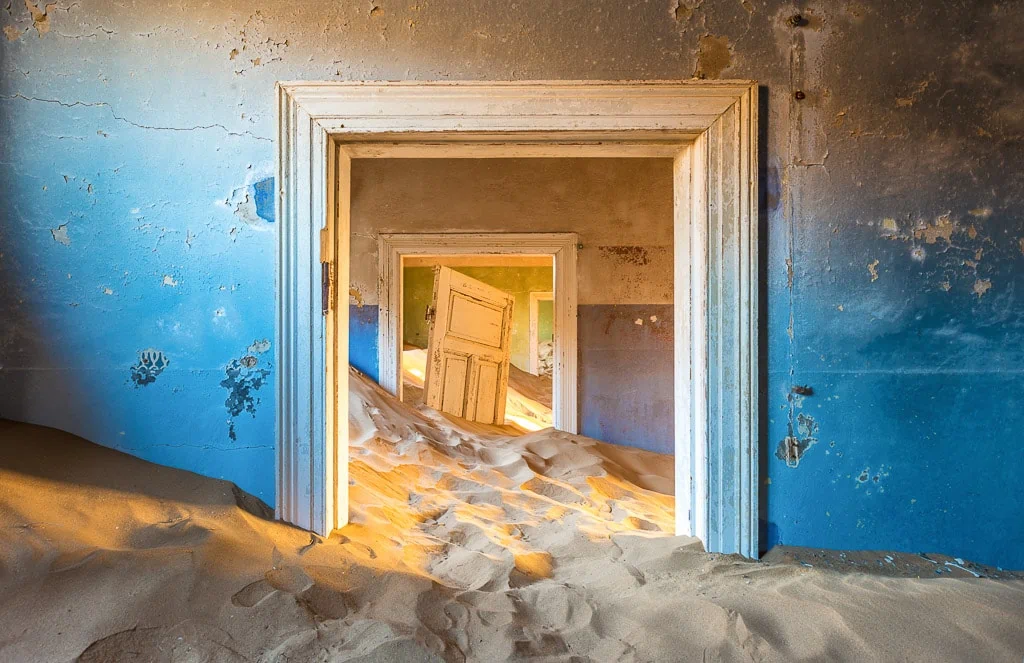
Day 6: Drive to Sossusvlei (overnight stopover)
Sossusvlei is the heart of the Namibian desert and home to burnt orange sand dunes and endless desert sands. It’s a long and mostly bumpy drive to the entrance to Sossusvlei, the Sesriem Gate of the Namib-Naukluft National Park, so consider breaking up the journey with an overnight stopover somewhere along the journey.
Drive time: stopover at accommodation approximately 4 hours from Luderitz and 3 from Sossusvlei
Where to stay between Luderitz and Sossusvlei
- Betta Camp: chalet style self catering 4 hours from Luderitz and 3 from Sossusvlei – check prices here!
- Duwisib Guest Farm: close to the medieval fortress Duwisib Castle, great farm stay, 4 hours from Luderitz and 3 from Sossusvlei – check prices here!
Click here for the best Duwisib hotel prices
Day 7 and 8: Sossusvlei
The Namib desert is believed to be the oldest in the world and the dunes of Sossusvlei among the most magnificent. If you want to see sunrise or sunset at the Sossusvlei dunes it’s mandatory to stay within the park as the park gates are otherwise closed for outside visitors until later in the morning. The iconic Deadvlei, the open plain where the isolated and long dead camel thorn trees stand, is another Sossusvlei must see.
Driving in Sossusvlei: the road to the park is gravel but we were comfortable travelling at 80k in our 4×4. Upon entering the park there is a tar road for about 45 minutes, at which point there is a car park for vehicles who can’t/prefer not to make the short 4×4 trip to Deadvlei and Sossosvlei. We did see drivers getting stuck in the deep sands so take care to follow the tracks carefully and avoid any parts which look too deep. If you’re not comfortable driving a 4×4 off road it may be wise not to attempt the deeper sand and use the shuttle instead.
Where to stay in Sossusvlei
- Sossusvlei Lodge and Seriem Camping: The luxury Sossusvlei Dune Lodge has sunrise and sunset access as does the more basic and budget friendly Sesriem Camping.
- Sossusvlei Lodge: If you can’t get into the park the Sossusvlei Lodge, adjacent to the park gates, is a decent option although the sunrise and sunset restriction still applies – check prices here!
- Godwana Desert Lodge: about 1 hour from the park entrance. Food and drinks were fantastic, the swimming pools a welcome break from the searing desert heat and the rooms comfortable – check prices here!
Click here for the best Sossusvlei hotel prices

Day 9: Solitaire
It’s time to leave the desert and make the journey back towards Walvis Bay and city life! The drive from Sossusvlei to Walvis Bay is a unique route which meanders through the Namib desert. Solitaire is a fun stop 1 hour from Sossusvlei and a great overnight option to split the journey especially if you’ve done a sunrise jaunt that morning in the desert. Visit the old school convenience store, grab a slice of the famous Apple Pie in Moose McGregor’s Desert Bakery and pose by the colourful car graveyard in the sand.
Drive time: 1 hour from Sossusvlei to Solitaire
Namibia itinerary travel tip: Solitaire is home to the only gas station between Sossusvlei and Walvis Bay so fill up if you need to!
Where to stay in Solitaire
- Solitaire Desert Farm: The Solitaire Desert Farm is the best option in the remote Solitaire – Check prices here!
Click here for the best Solitaire hotel prices
Day 10: Walvis Bay
We spent the night in the waterfront town of Walvis Bay famous for its huge population of pink flamingos which line the lagoon in the late afternoon. Dune 7, the highest sand dune in Namibia, is located on the outskirts of the towns and is well worth the challenging climb to enjoy some dune adventures! En route stop at the Tropic of Capricorn, one of the five major circles of latitude, marked by a sign on either side of the C14 road between Solitaire and Walvis Bay. The drive also meanders in and out of Africa’s largest conservation area, the Namib-Naukluft National Park. It encompasses desert and mountains and is Namibia’s greatest natural wonder.
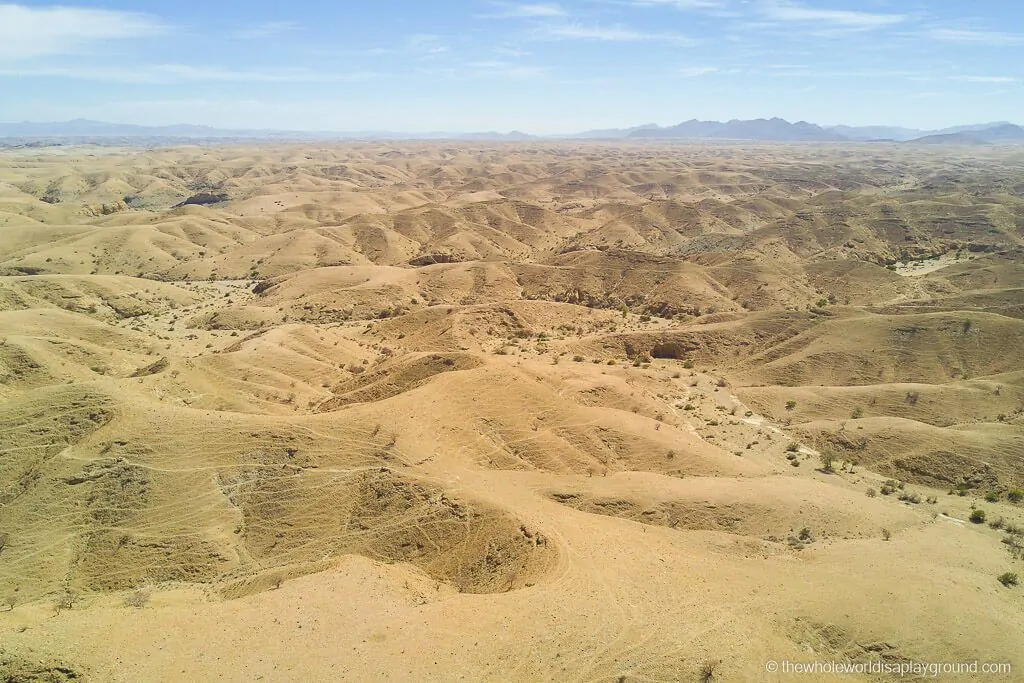
Drive time: it’s a 3 hour drive from the Solitaire to the Walvis Bay. The drive is beautiful but the roads are bumpy at times so exercise care. A large portion of the drive passes through a long and straight road in the Namib-Naukluft National Park – the vast surroundings can be quite hypnotizing so switch up drivers or take plenty of breaks.
Where to stay in Walvis Bay
- Protea Pelican Bay: We stayed in the modern Protea Pelican Bay located on the waterfront. It’s only a short walk to the Raft Restaurant which is a dining highlight – Check prices here!
- Flamingo Villas Boutique Hotel: two minutes walk from the beach and boasts some of the best views in Walvis Bay – Check prices here!
Click here for the best Walvis Bay hotel prices
Day 11: Swakopmund
A Namibian town with heavy German influences, Swakopmund is the largest coastal town in the country and the perfect stopover between the desert and the Skeleton Coast. The palm tree-lined streets and busy seaside promenade are a world away from the isolated desert life of Sossusvlei. It’s a fun stopover and the perfect stop to eat, drink and relax while stocking up on supplies!
Drive Time: 30 minutes from Walvis Bay to Swakopmund
Namibia itinerary travel tip: For a real eyeopener check out Peter’s Antiques which sells genuine artifacts from the 19th century: politically incorrect can’t even begin to describe the paraphernalia on the shelves.
Where to stay in Swakopmund
- Beach Hotel Swakopmund: is a also a great option – check prices here!
- Namib Guesthouse: clean and comfortable with great breakfast, a quiet guesthouse 10 minutes walk from the beach – check prices here!
Click here for the best Swakopmund hotel prices
Day 12: Cape Cross, Skeleton Coast
Shipwrecks and seals lead visitors up to the Skeleton Coast where the treacherous coastline has long been a graveyard for unsuspecting ships. It’s possible to explore part of the coast by car and, on a shorter itinerary, Swakopmund to Cape Cross is the ideal introduction. There are shipwrecks on both the land and shore and a 100,000 strong seal colony at Cape Cross.
Drive time: It’s just over 90 minutes to Cape Cross from Swakopmund.
Namibia itinerary travel tip: Bring a scarf to Cape Cross, we promise you’ll will need it! 100,000 seals, while adorable, bring an aroma that is hard to describe. To put it bluntly, there was definitely gagging for the first few minutes of our visit but it did ease off a little as we became used to it!
Where to stay on the Skeleton Coast
- Daureb Isib Campsite and B&B: in the foothills of Brandberg Mountain, the highest in Namibia, Daureb Isib means view the Brandberg. Homely rooms and great views – check prices now!
- Cape Cross Lodge: beautiful rooms, incredible fish dishes and good location (a safe enough distance from the seals so that your nose will thank you!)
Click here for the best Skeleton Coast hotel prices
Day 13: Skeleton Coast
Day 12 requires an early start to travel to the Messum Crater, the lichen fields endemic of Namibia, 2000 year old Welwitschia plants (the only known fossils dating back to the Jurassic Age) and, if you have time and inclination, the Ugab Gate to the Skeleton Coast Park marked by what else but skeleton images!
Namibia itinerary travel tip: today’s drive is a journey into the wilderness and, while the road conditions are fine, it could be a while before help comes along if things do go awry. Stay on the main roads, plan your route accordingly and let your accommodation know your plans. An alternative is to take a tour and sit back and relax while someone else does the driving!
Where to stay on the Skeleton Coast
- Daureb Isib Campsite and B&B: in the foothills of Brandberg Mountain, the highest in Namibia, Daureb Isib means view the Brandberg. Homely rooms and great views – check prices now!
- Cape Cross Lodge: beautiful rooms, incredible fish dishes and good location (a safe enough distance from the seals so that your nose will thank you!)
Click here for the best Skeleton Coast hotel prices
Day 14: Damaraland via Spitzkoppe
Switching coast for safari Etosha is the next stop on our Namibia itinerary and the journey from Cape Cross through Damaraland takes in one of the most scenic areas in Namibia. From Cape Cross it is a 2 hour 30 minute drive to the granite peaks of Spitzkoppe.
Drive time: 5 hours from Cape Cross to Madisa Camp via Spitzkoppe
Where to stay Damaraland
- Madisa Camp: charming and rustic campsite, basic accommodation with outdoor bathrooms under the stars – check prices now!
Click here for the best Damaraland hotel prices

Day 15 and 16: Damaraland
Damaraland is home to the ancient Twyfelfontein Rock Engravings, a UNESCO World Heritage site. The Petrified Forest is another interesting Damaraland stop as are viewing the wild desert elephants that live in the riverbed areas of the region.
Drive time: From Madisa Camp it is 3 hours to Huab Lodge or 4 hours to Kaoko Bush Lodge via Twyfelfontein and the Petrified Forest.
Where to stay Damaraland
- Huab Lodge: the Huab Lodge, with its spacious bungalows and beautiful river views, is a good stopover option en route to Etosha – check prices now!
- Kaoko Bush Lodge: cosy lodges and good food – check prices now!
Click here for the best Damaraland hotel prices

Days 17 to 19 : Etosha National Park
Etosha National Park is the most renowned wildlife area of Namibia with a salt pan so large it can apparently be seen from space. Famed for its watering holes, which are magnets for wildlife, Etosha is a highlight of any Namibia itinerary.
Drive time: 2 hours to Etosha but depends on where you enter the park.
Namibia itinerary travel tip: camps with watering hole views are highly sought after in Etosha where the after dark action is amazing to watch from the comfort of your cabin. Book well in advance for the best views!
Where to stay in Etosha National Park
- Okaukuejo, Halali, Dolmite, Namutoni and Onkoshi are the camps within the park. Okaukuejo Rest Camp, although touristy and busy, has one of the best watering holes in Etosha. Onkoshi and Dolomite are luxury options with incredible views and exclusive game viewing.
- Gondwana Etosha Safari Lodge: 10 km from the park entrance good accommodation with easy access to the park – check prices now!
- AHA Eagle Tented Lodge & Spa: luxury tents 40km/1 hour from Etosha, good choice for one night stay – check prices now!
Click here for the best Etosha hotel prices
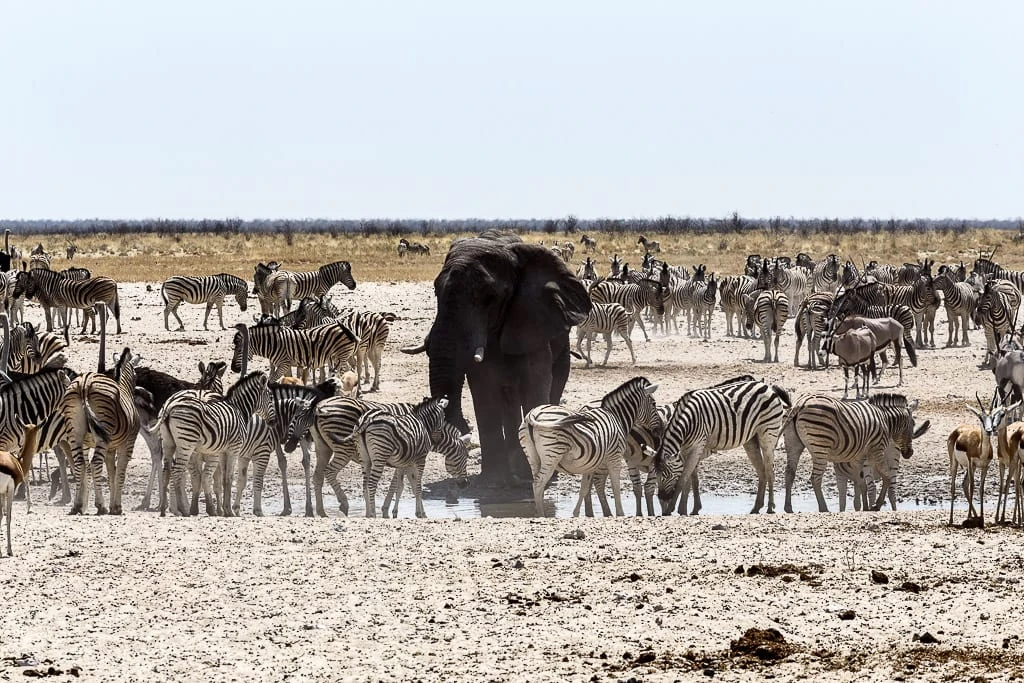
Day 20: Windhoek
After leaving Etosha it’s time for a return to Windhoek to depart Namibia.
Drive time: 4 hours 15 minutes from Okaukuejo via Anderson’s Gate in Etosha.
Where to stay in Windhoek
- Hilton Hotel Windhoek: clean and comfortable choice. We woke up refreshed for our drive the next day – check prices here!
- Hotel Thule: The Hotel Thule, high on a hill above Windhoek, is another good choice for a night in Windhoek – check prices here!
Click here for the best Windhoek hotel prices
Extending the itinerary
Our detailed itinerary is ideal for a three-week trip but there are other Namibia highlights which you might wish to include if you have additional time in either country:
- Extend the time in Northern Namibia to explore the Himba culture and the relatively untouched Caprivi Strip for wildlife or travelling further up the Skeleton Coast.
- Combine with an extended itinerary to include the Okavango Delta in Botswana and Victoria Falls – we’ve done this route before, you can check our itinerary here
For more on Namibia:
- Check out our driving tips for Namibia here
- Read more about our favourite stops on the drive between Sossusvlei and Swakopmund
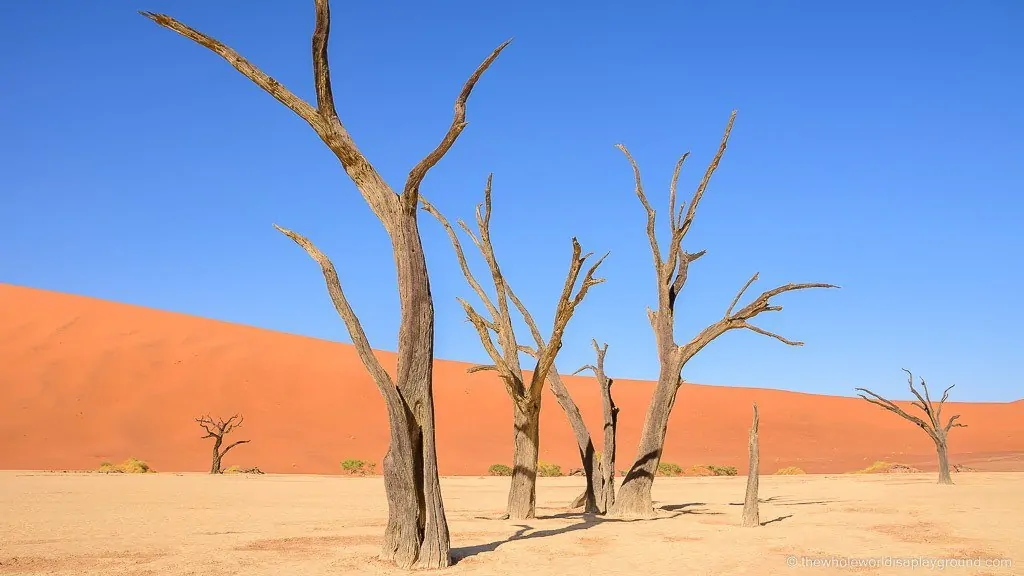



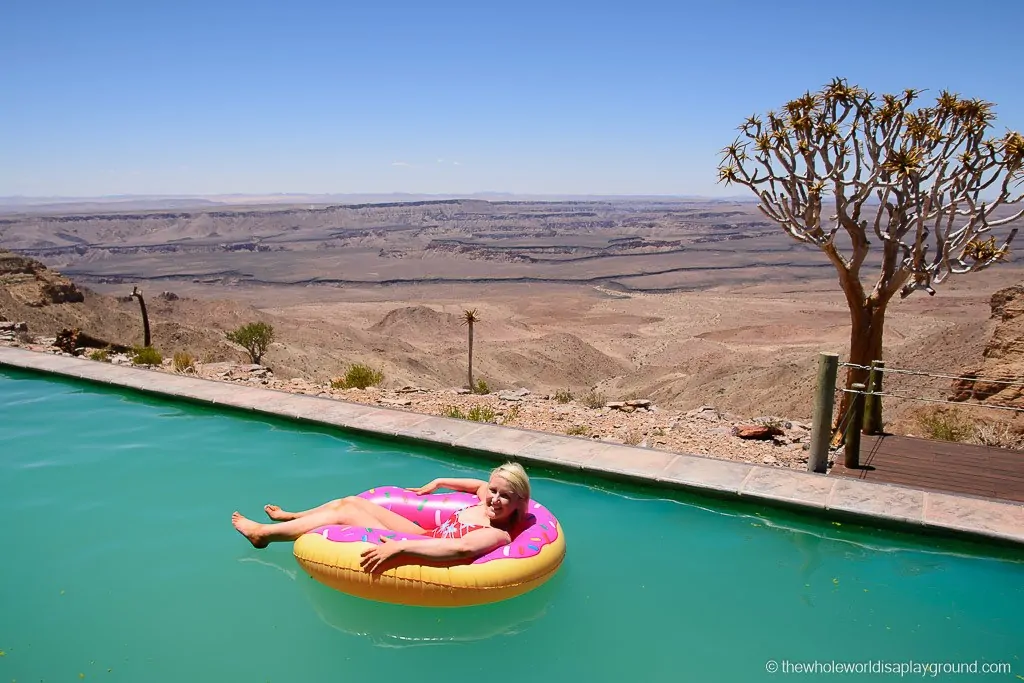



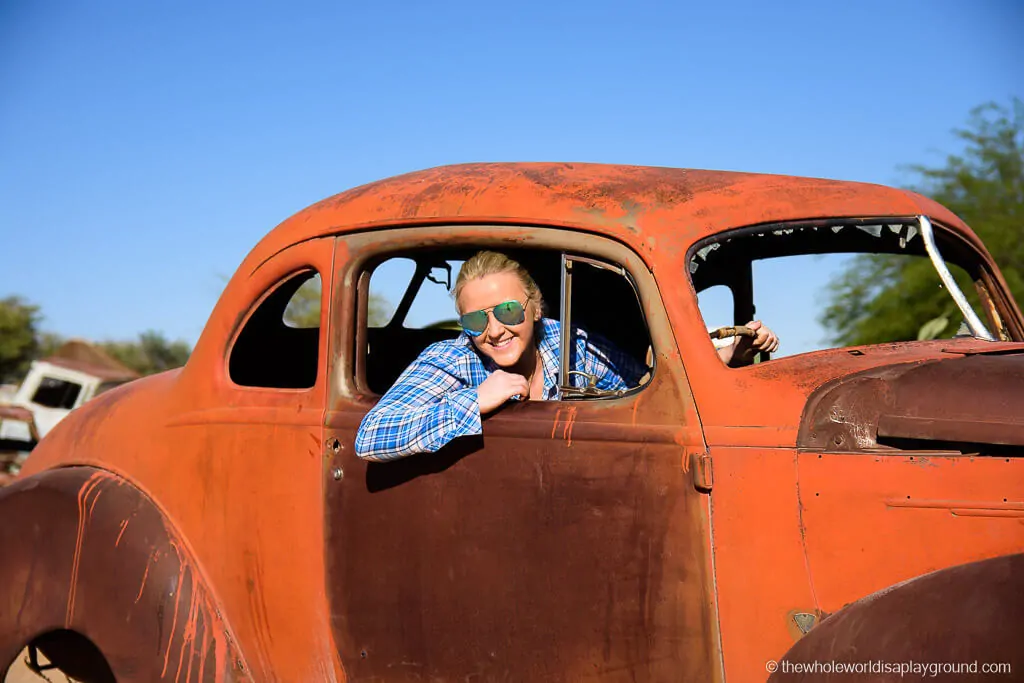


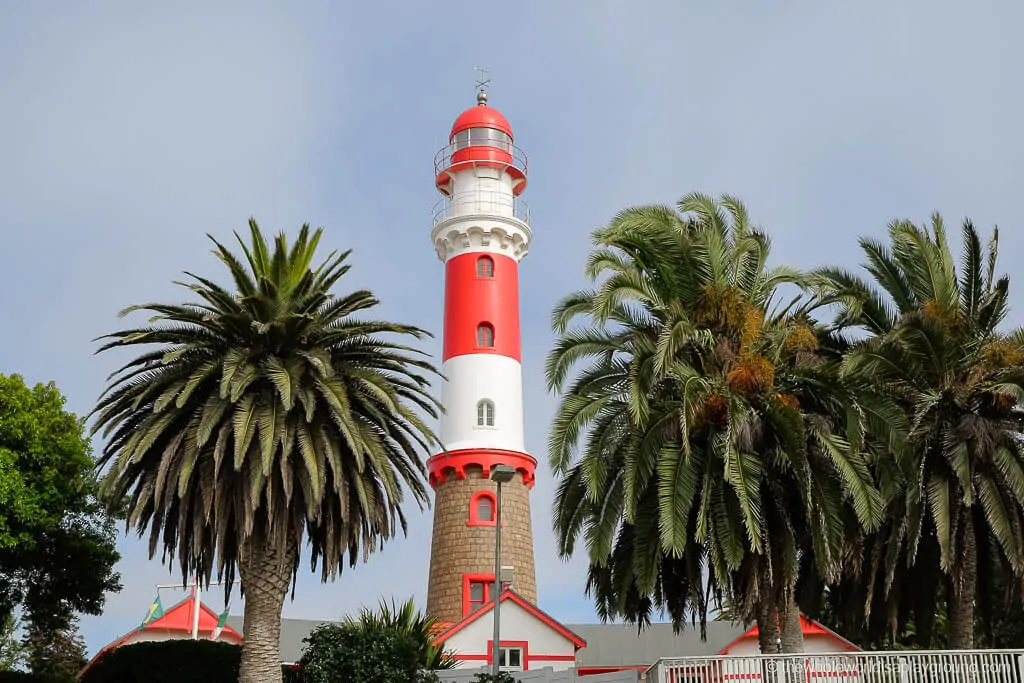
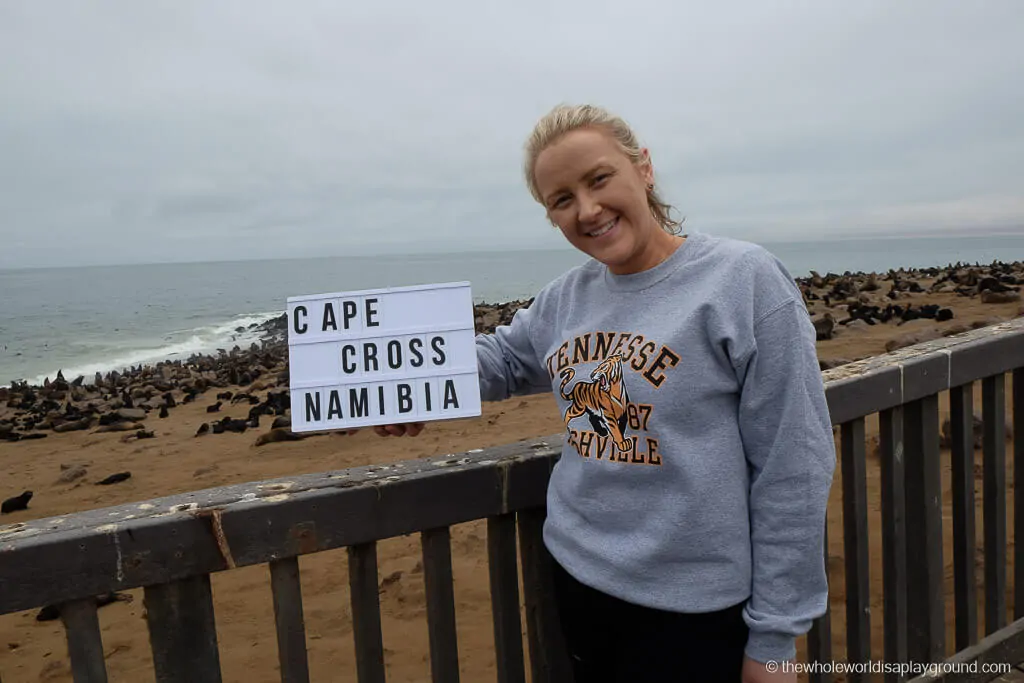


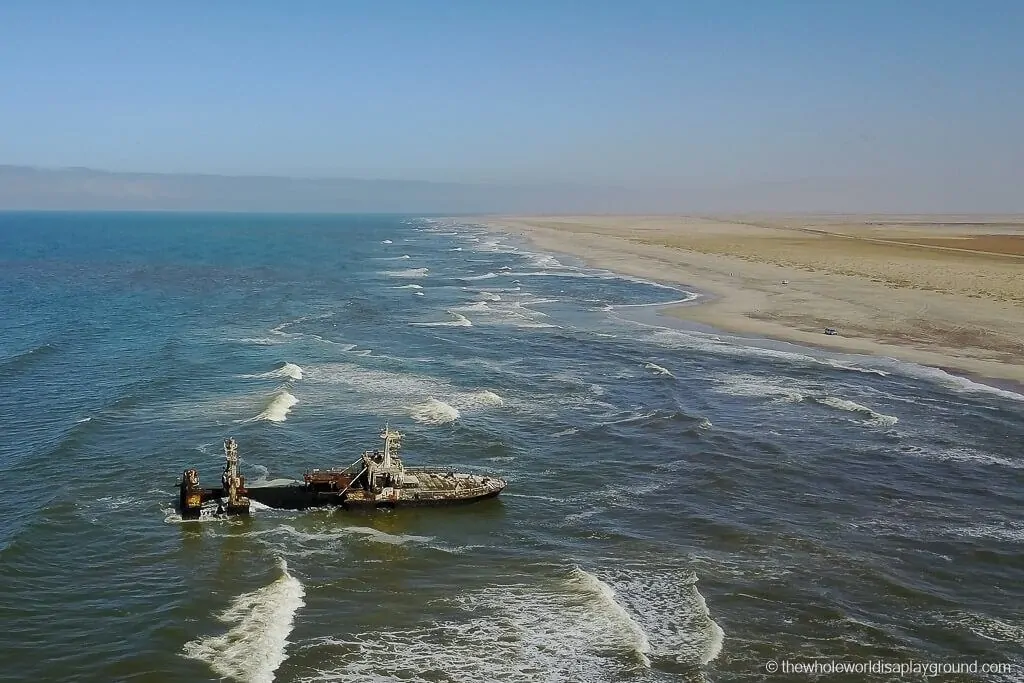
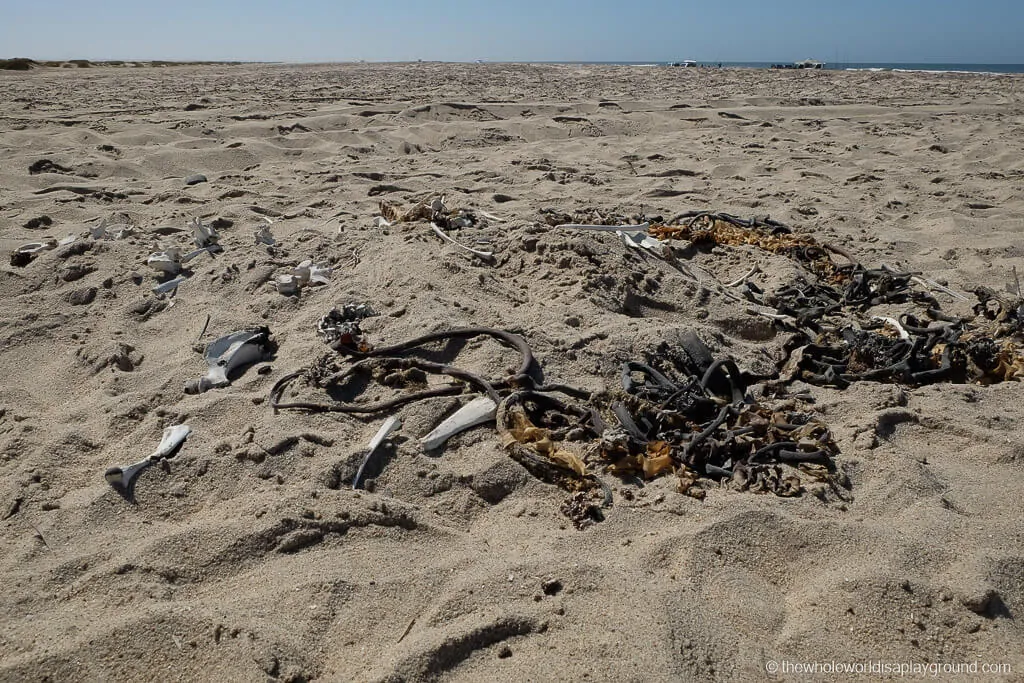
HI guys, great info on Namibia! Can I ask which time of the year you went? As you caught great Safari it seems! Thanks, Ri
Hi Ri
We’ve been in September, December and January. Etosha is pretty good for most of the year, January to March are the rainy months but still worth a visit.
Elaine
Thanks so much for this, so useful! We are planning to go this summer. My question is, is it worth the trek to fish river canyon? We are finding that all accommodation is booked, except for a campsite and it seems a long way to go. We’re thinking if we gave it a miss and just went as far south as Sossusvlei instead that would give us more time in Damaraland/Etosha etc. Thoughts?
Hi Louise,
Your plan sounds good too! We loved Fish River Canyon (it’s similar to visiting the Grand Canyon if you’ve been) but the accommodation really made it spectacular for us so that would definitely impact my decision – it is a lot of extra driving (our lodge had a few hours off road as well on top of the journey there!) so there’s definitely a trade-off. We adore safari so spending more time in Etosha is a winner for us!
Have an awesome trip!
Elaine
Hey! From the looks of it, you guys rented a non-camper truck and stayed in camps/hotels without camping. Would you recommend that? Or would you maybe try camping on your next Namibia itinerary? And anywhere else you didn’t go in this itinerary that you’d try to visit next trip?
Hi Chris
We had a 2 month old and my mum on part of the trip so we stuck to hotels! Camping is a great option and we saw others with the roof top tents but not sure it would work for babies and grannies!!
I’d love to spend more time in Sossusvlei, Caprivi Strip, fly higher into the Skeleton Coast and have way more time for Etosha! Namibia is incredible.
Elaine
Hi Elaine,
Thank you so much for sharing . You travel tips on road conditions through Namibia is so helpful .
I’m a South African planning a self drive in my own little car next year and your blog has helped me plan my trip better to avoid any 4×4 tracks regions. I can always take day tours to the dunes ect..
Take care …
Sam
Thanks Sam, so happy it was helpful. Hope you have a great trip.
Elaine